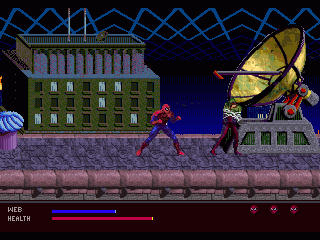Retro Replay Review
Gameplay
The Amazing Spider-Man: Web of Fire presents classic side-scrolling action that will feel both familiar and fresh to longtime fans of 16- and 32-bit era platformers. You guide Spider-Man through a series of urban environments twisted by an electric plasma grid unleashed by HYDRA, battling hordes of mechanical gargoyle-like enemies and heavily armed operatives. Combat revolves around a mix of melee kicks, punches, and Spider-Man’s signature web-fluid attacks, giving you a balanced arsenal for crowd control and single-target takedowns.
Movement is one of Web of Fire’s strongest suits. Spider-Man can scale walls, cling to surfaces, and create web “vines” to swing across wide gaps. These swings aren’t just for show—they’re essential for navigating broken rooftops and skipping past deadly hazards. The web-bar resource system adds a layer of strategy: each special attack and vine swing drains the bar, forcing you to decide when to expend web fluid for offense or traversal, and when to conserve it until you find replenish items scattered across levels.
Adding to the mix is the Daredevil rescue subplot, which functions as both a narrative beat and a gameplay mechanic. Once you free Daredevil, you unlock his unique screen-clearing attack. Activating this special ability unleashes a flurry of strikes that can turn the tide in boss fights or overwhelming enemy hordes. Daredevil’s assistance not only adds a satisfying variety to combat, but also encourages replaying earlier levels to experiment with different timing and combo chains.
Graphics
As a title for the Sega 32X, Web of Fire pushes the hardware with richly detailed sprite work and vibrant backgrounds. The New York cityscape warped by HYDRA’s plasma grid radiates ominous energy in electric hues of pink and teal, creating a moody atmosphere that stands out from more conventional comic-book color schemes. Character sprites are large and animated with fluidity, capturing Spider-Man’s acrobatic flair and the mechanical menace of the gargoyle drones.
The game’s attention to detail extends to its particle effects and layer-scrolling techniques. Web swings leave colorful tracer lines, explosions produce chunks of debris, and the plasma grid pulses in the background, giving environments a dynamic, lived-in feel. Even minor enemies display unique attack patterns and visual flairs, ensuring each encounter remains visually engaging.
Where the graphics truly shine is in boss encounters, which often feature multi-segment animations and elaborate set pieces. Whether you’re outrunning a monstrous HYDRA mech through flaming streets or dodging electrical storms on a rooftop, the game stages its climactic battles with cinematic flair. While a few texture elements can appear blocky at times, the overall presentation is polished and evocative, showcasing what the 32X add-on could achieve at its peak.
Story
The narrative premise is straightforward yet compelling: an electric plasma grid has plunged New York into chaos, and only Spider-Man can prevent total destruction. HYDRA takes center stage as the nefarious mastermind organization, deploying sinister machines reminiscent of gargoyle statues that come to life and terrorize the city. The stakes feel real as you traverse crumbling streets, sewers overrun with robotic monstrosities, and skyscrapers crackling with unstable energy.
Plot progression is delivered through brief cutscenes and in-game dialogue that keeps the pace brisk. Though the story doesn’t reinvent the wheel, it pays faithful homage to classic Spider-Man lore—complete with heroic sacrifices, dark conspiracies, and the introduction of Daredevil as a captive ally. Rescuing Daredevil not only serves as a pivotal narrative moment, but also deepens the sense of shared heroism as you watch two street-level vigilantes unite against overwhelming odds.
What stands out is the game’s ability to weave its story into gameplay beats. Each level feels motivated by HYDRA’s unfolding plot: you chase generators powering the plasma grid, disable transmission towers, and finally confront the organization’s lead scientist. The result is a cohesive experience where action and narrative support one another, ensuring that every swing of your web and every boss fight ties back to the high-voltage threat looming over New York.
Overall Experience
The Amazing Spider-Man: Web of Fire delivers a rewarding mix of fast-paced action, platforming finesse, and comic-book flair. Its well-balanced difficulty curve makes it accessible to newcomers, while its secret paths, web-bar management, and Daredevil assist system provide depth for seasoned players seeking mastery. Levels are varied, challenging, and often encourage creative use of web swings and special attacks to outmaneuver foes.
Although the game’s limited release on the 32X makes it a rare find for collectors, those who get their hands on it will appreciate its high production values and tight controls. The audio complements the on-screen chaos with punchy sound effects and an energetic soundtrack that captures the urgency of HYDRA’s takeover. Minor quibbles—such as occasional slowdown in the busiest scenes—do little to derail the overall momentum.
In summary, Web of Fire stands as a hidden gem in Spider-Man’s gaming catalogue. Its polished presentation, engaging mechanics, and heroic storyline make it a must-play for fans of side-scrolling action and comic-book adaptations alike. Whether you’re revisiting it for nostalgia or discovering it for the first time, Spider-Man’s battle against HYDRA is a thrilling ride from start to finish.
 Retro Replay Retro Replay gaming reviews, news, emulation, geek stuff and more!
Retro Replay Retro Replay gaming reviews, news, emulation, geek stuff and more!









Reviews
There are no reviews yet.